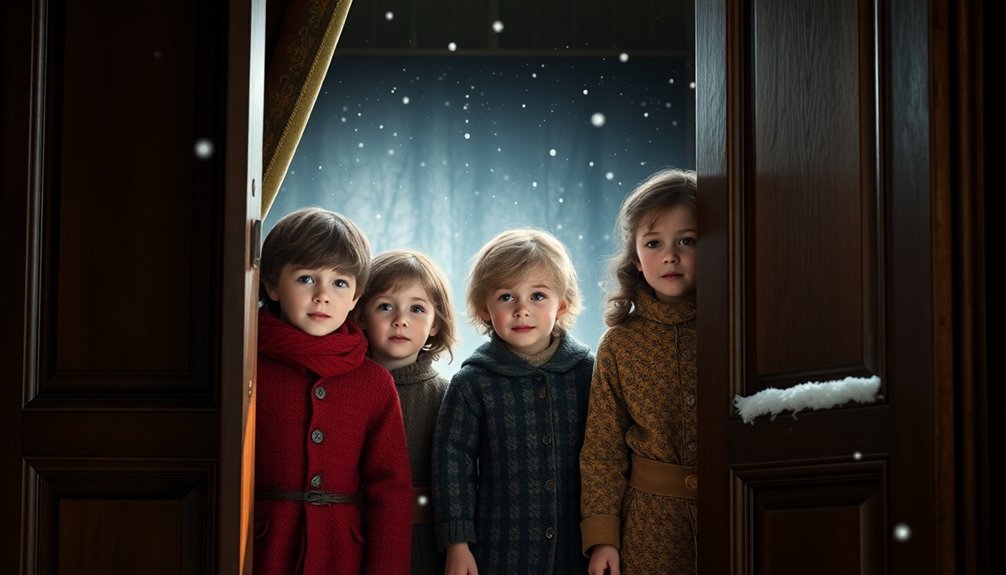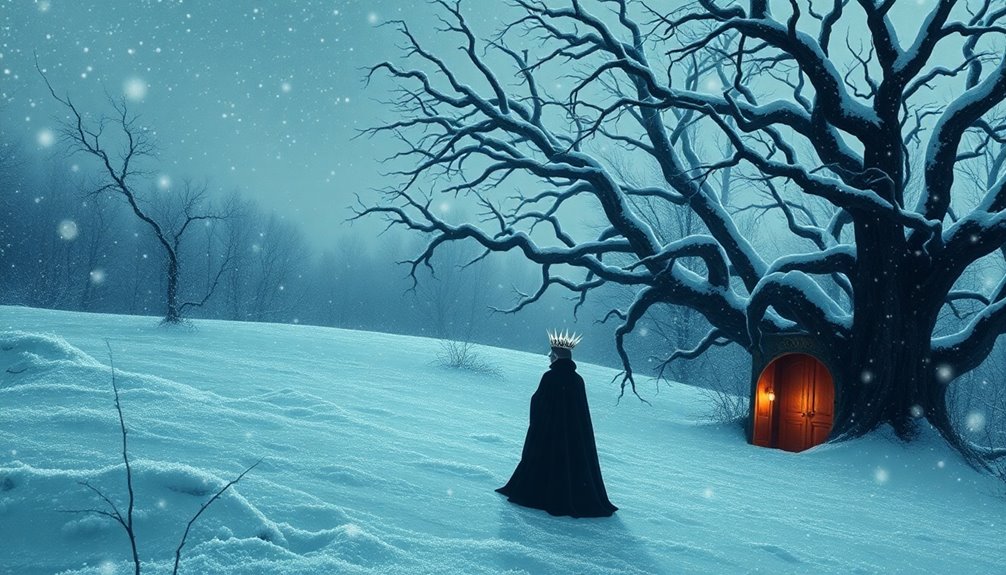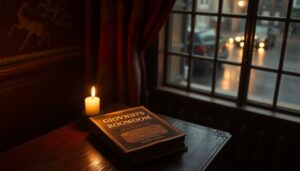In "The Lion, the Witch, and the Wardrobe," you witness the Pevensie siblings' journey through the mysterious wardrobe into Narnia. They face challenges, forge friendships, and confront betrayal, especially with Edmund's temptation by the White Witch. Aslan's powerful presence symbolizes hope and redemption, culminating in personal growth for each sibling. The battle between good and evil unfolds, showcasing themes of courage and unity. There's so much more about the magical world of Narnia waiting for you to explore.
The Pevensie Siblings: A Journey Begins

As the Pevensie siblings adjust to their new life in the countryside, their adventure truly begins when Lucy discovers Narnia hidden within an old wardrobe.
While exploring the professor's vast house, she stumbles into a magical journey filled with wonder. Lucy meets Tumnus, the Faun, who shares the chilling tale of the White Witch's eternal winter, sparking her excitement. This enchanted world is filled with mythical creatures that both challenge and aid the siblings on their quest. Throughout their journey, the siblings learn about the importance of strong female protagonists like Lucy, who embody resilience and courage in the face of adversity.
However, her siblings—Peter, Susan, and Edmund—are skeptical of her enchanting stories, with Edmund even teasing her about her "imaginary friend."
Yet, their doubts fade as they all enter Narnia together, drawn by curiosity and the thrill of the unknown. This marks the start of a grand quest that challenges their courage and unity against the powerful White Witch. The siblings soon learn about Deep Magic that governs Narnia and the consequences of their actions in this mystical world.
Discovering Narnia: The Wardrobe's Secret
When you step into the Professor's wardrobe, you uncover its magical secret and enter a world unlike any other.
Lucy's first encounter with the faun Tumnus sparks a thrilling adventure, but her siblings remain skeptical about her fantastical tale. The enchanting world of Narnia is filled with mystical elements that captivate the imagination. The Pevensies' journey also mirrors the resilience and strength of individuals overcoming adversity.
This mix of wonder and doubt sets the stage for the Pevensies' remarkable journey in Narnia. The narrative echoes themes of bravery and resilience, as the Pevensies face challenges that test their courage and unity in a fantastical realm.
Magical Portal Unveiled
Discovering the wardrobe's secret transports you into a world of magic and adventure.
As you step inside, you find more than just coats; you find a gateway to Narnia, where Lucy first explored the snowy landscape.
The wardrobe's interior hides the enchanting threshold, revealing:
- The breathtaking beauty of Narnia
- The whimsical characters like Mr. Tumnus
- The eternal winter caused by the White Witch
- The shift from the mundane to the extraordinary
- The beginning of a heroic journey for the Pevensie siblings
This magical portal invites you to embrace the unknown, setting the stage for battles between good and evil.
With every turn of the coat, you sense the thrill of adventure waiting just beyond the fabric.
Lucy's First Encounter
Stepping through the wardrobe leads you to an extraordinary moment: Lucy Pevensie's first encounter with Narnia.
As you emerge from the magical portal, a winter wonderland unfolds before you, shrouded in snow and mystery. It's here that Lucy meets Mr. Tumnus, a charming faun who initially contemplates betraying her to the oppressive White Witch.
However, he soon chooses friendship over treachery, revealing the warmth beneath the cold surface of Narnia. Lucy discovers the land is under the Witch's cruel rule, forever trapped in an eternal winter.
This enchanting adventure ignites her spirit, but when she returns to share her story, her siblings dismiss her claims, unaware of the magic that awaits them all in Narnia.
Sibling Skepticism Emerges
How can something so extraordinary be dismissed so easily? When Lucy first shares her adventure in Narnia, her siblings' skepticism reigns supreme. Instead of embracing her discovery, they tease her, casting doubt on the existence of the magical land. This disbelief not only isolates Lucy but also complicates the journey ahead.
- Lucy's excitement clashes with their indifference.
- Edmund's teasing deepens the divide.
- They can't find the wardrobe's entrance again.
- Their skepticism clouds their judgment.
- The truth waits in the shadows.
As the siblings grapple with their disbelief, they miss the chance to explore Narnia together.
Only later do they realize the wonders of Lucy's adventure, transforming skepticism into shared discovery.
The Magic of Narnia: Friendships and Betrayals
In Narnia, friendships and betrayals shape the destinies of its characters. You see how Lucy's bond with Mr. Tumnus highlights trust, while Edmund's betrayal reveals the dangers of temptation. The complexities of memory, regret, and self-reflection in their relationships mirror the emotional landscapes explored in other narratives as well. As the siblings band together against the White Witch, their journey underscores the power of unity amidst conflict. This theme of societal norms resonates with the complexities faced by characters in other narratives, such as those in Revolutionary Road. The characters' resilience in the face of adversity echoes the way acts of courage are portrayed in stories like The Book Thief.
Friendship With Mr. Tumnus
While exploring Narnia, Lucy Pevensie's friendship with Mr. Tumnus blossoms in his cozy home, where they share laughter and warmth. This bond highlights the magic inherent in Narnia, a stark contrast to the looming threat of the White Witch.
- Mr. Tumnus's initial betrayal plan shows moral conflict.
- They connect through shared struggles against tyranny.
- His loyalty to Lucy deepens their friendship.
- Lucy's determination to rescue him exemplifies true bravery.
- Their alliance becomes a beacon of hope for Narnia.
Ultimately, their friendship not only emphasizes loyalty but also illustrates how connections can spark courage and action against oppressive forces, making their story a pivotal element of Narnia's enchanting narrative.
Edmund's Betrayal and Consequences
Edmund Pevensie's betrayal shakes the foundation of his family's trust, as he succumbs to the White Witch's temptations of power and Turkish Delight. By secretly visiting her, he misleads his siblings about Narnia's reality, exploiting their belief in unity.
This greed turns him into an unwitting pawn in her schemes, creating tension and distrust among the Pevensies, especially for Lucy, who feels isolated and hurt. His actions inadvertently warn the Witch of Aslan's return, threatening the safety of his family and Narnia's inhabitants.
However, Edmund's journey ultimately leads to redemption. Aslan's self-sacrifice not only saves him but also restores his honor, highlighting themes of forgiveness and transformation within the narrative.
Unity Against the Witch
Unity emerges as a powerful force in the battle against the White Witch, binding the Pevensie siblings and their newfound allies in Narnia.
You witness how their relationships strengthen, especially after Edmund's betrayal. As they regroup, you see the essence of teamwork:
- Mr. and Mrs. Beaver guide the way forward.
- Lucy's friendship with Mr. Tumnus symbolizes hope.
- The siblings lean on each other for strength.
- Forgiveness transforms Edmund's life, allowing him to reclaim his place.
- They unite not just against evil, but for something greater.
Through these connections, they discover that unity against the Witch is their greatest weapon.
Each bond formed serves as a demonstration of resilience, proving that together, they can overcome darkness.
The Call to Adventure: Assembling Allies
As the Pevensie siblings step into the enchanting world of Narnia, they quickly discover that their journey hinges on assembling allies to stand against the formidable White Witch.
Mr. Beaver reveals the prophecy that two Sons of Adam and two Daughters of Eve must sit on the thrones of Cair Paravel, underscoring the importance of seeking out Aslan, the true king. This quest emphasizes the theme of resilience and personal growth, as the siblings navigate their challenges and develop their strengths. The challenges they face in Narnia resonate with the struggles depicted in *A Tree Grows in Brooklyn*, where immigrant experience highlights the fight for survival and community support.
Lucy's determination to rescue Mr. Tumnus unites her siblings, igniting their quest. Though Edmund's betrayal initially isolates him, it highlights the need for solidarity among the remaining siblings.
The arrival of Father Christmas and his empowering gifts symbolizes hope, while the Beavers' support emphasizes the strength found in community.
Together, they prepare to confront the challenges ahead. This quest for allies mirrors the themes of power and corruption found in historical mysteries like *The Daughters of Night*.
The Dark Forces: The White Witch's Reign

You can feel the chilling grip of eternal winter in Narnia, where the White Witch's reign casts a shadow over every corner. Her manipulation of characters like Edmund reveals the depths of temptation and betrayal she wields to maintain her power. The White Witch's character serves as a reflection of systemic oppression that highlights the impact of her rule on the inhabitants of Narnia. In her quest for dominance, the White Witch employs surveillance and control tactics that mirror the oppressive regimes found in dystopian societies. As you explore this dark force, the struggle between good and evil becomes ever more apparent. The consequences of unrequited love echo throughout the narrative, highlighting the impact of obsession on the characters' fates.
Eternal Winter's Grip
Despair blankets Narnia under the oppressive rule of the White Witch, Jadis, who casts a chilling spell that plunges the land into an eternal winter.
Fear grips the hearts of its inhabitants as she ruthlessly turns dissenters into stone, suffocating hope.
Yet, whispers of change begin to stir, hinting at the return of light.
- The White Witch's icy reign symbolizes despair.
- Aslan represents warmth and hope.
- Edmund's betrayal showcases her manipulative power.
- The prophecy foretells her downfall.
- Spring's approach signals a new beginning.
In this clash between good and evil, the arrival of Aslan ignites a flicker of hope, promising liberation from the Witch's dark grip and the return of joy to Narnia.
Temptation and Betrayal
While the eternal winter casts a shadow over Narnia, the White Witch's insidious nature thrives on temptation and betrayal. She expertly manipulates Edmund, exploiting his greed with the promise of Turkish Delight and the allure of power. This leads him to betray his siblings, believing he'll find glory by aligning with her.
The Witch's reign creates an atmosphere of fear, turning those who defy her into stone, which cements her control over Narnia. Edmund's betrayal underscores a profound vulnerability; isolated from his family, he succumbs to the dark forces at play.
This contrast between the White Witch's cold oppression and Aslan's warm hope highlights the ongoing struggle between good and evil, emphasizing the high stakes of loyalty and trust.
Aslan: The Symbol of Hope and Strength
Hope radiates through Aslan, the majestic lion who embodies the spirit of courage and self-sacrifice in *The Lion, the Witch, and the Wardrobe*. His presence brings a magic that inspires the Pevensies and all of Narnia.
Aslan's actions reveal his unwavering strength:
- He represents the promise of redemption.
- His sacrifice on the Stone Table highlights themes of forgiveness.
- The breaking of the Table symbolizes triumph over death.
- Aslan's leadership unites the creatures of Narnia.
- He stands against the oppressive White Witch, restoring hope.
Through Aslan, you witness the essence of true strength—where hope flourishes amidst despair.
He reminds you that even in darkness, the light of sacrifice and courage can guide the way.
The Sacrifice: A Turning Point in the Story

As you consider Aslan's selfless act at the Stone Table, you can't help but feel the weight of his sacrifice.
This moment not only highlights the theme of redemption but also sets the stage for the emotional journey of Lucy and Susan.
Aslan's choice reflects the profound impact that love and sacrifice can have on the fight for Narnia's future.
Aslan's Selfless Act
Sacrifice lies at the heart of Aslan's selfless act, a moment that irrevocably changes the course of Narnia's fate.
You witness the profound implications as Aslan willingly lays down his life on the Stone Table to save Edmund from the clutches of the White Witch. This pivotal moment not only signifies despair but also sets the stage for redemption and hope.
- Aslan's sacrifice highlights true love.
- The White Witch believes she's secured victory.
- Lucy and Susan bear witness to the heart-wrenching scene.
- The breaking of the Stone Table reveals Deeper Magic.
- Aslan's resurrection symbolizes the ultimate triumph over evil.
Aslan's selflessness transforms despair into hope, paving the way for spring's restoration in Narnia.
Impact on Redemption
Redemption unfolds dramatically in the wake of Aslan's selfless act on the Stone Table. His sacrifice not only saves Edmund from the clutches of the White Witch but also exemplifies the profound themes of redemption and selflessness woven throughout the story.
The Witch's claim over Edmund due to his betrayal highlights the weight of sin and the necessity for atonement. Aslan's death fulfills her demands, illustrating the complex interplay of good and evil.
However, his resurrection reveals the power of deeper magic, signifying the ultimate triumph of good over evil.
Edmund's transformation from traitor to redeemed king embodies the narrative's focus on forgiveness, showcasing how personal growth can emerge from wrongdoing, ultimately offering hope and renewal for all characters involved.
Resurrection: The Power of Renewal
Resurrection embodies the profound power of renewal, a theme that resonates deeply throughout "The Lion, the Witch, and the Wardrobe."
When Aslan rises from the dead after his sacrificial act, it marks a pivotal moment in Narnia's history, symbolizing the triumph of good over evil. His resurrection shatters despair and restores hope, leading to a revitalization of the land.
- The breaking of the Stone Table reveals deeper magic.
- Lucy and Susan's grief transforms into joy.
- Petrified creatures come back to life.
- Spring returns, banishing the White Witch's winter.
- Aslan's victory signifies a universal theme of rebirth.
This powerful renewal in Narnia illustrates that even in darkness, hope and life can triumph once more.
The Final Battle: Good vs. Evil
The final battle in *The Lion, the Witch, and the Wardrobe* erupts with fierce determination as Aslan rallies the Pevensie siblings and their allies against the White Witch's formidable forces at the Stone Table.
As the clash intensifies, Peter confronts Maugrim, demonstrating his bravery and marking a pivotal moment in their fight against evil.
With Aslan's resurrection, the petrified creatures from the Witch's castle rise, restoring hope and strength to their army.
The battle reaches its climax when Aslan defeats the White Witch, shattering her reign of terror and symbolizing the triumph of good over evil.
Following this victory, the Pevensie siblings are crowned as Kings and Queens of Narnia, heralding a new era of peace and order in this magical land.
Themes of Unity and Community
Unity and community emerge as essential themes in *The Lion, the Witch, and the Wardrobe*, driving the Pevensie siblings' journey through Narnia. You see how teamwork is crucial as they combine their strengths to face the White Witch. Their alliances, like Lucy's friendship with Mr. Tumnus and the Beavers, highlight the importance of collaboration.
- Edmund's betrayal illustrates the fragility of trust.
- Father Christmas symbolizes hope and rekindles unity.
- The gifts he provides empower the siblings.
- The final battle showcases the power of community.
- Allied forces unite under Aslan's leadership.
Through these experiences, you witness how unity fosters resilience and the ability to overcome adversity, emphasizing the strength found in togetherness.
The Role of Courage and Redemption
Courage and redemption play pivotal roles in *The Lion, the Witch, and the Wardrobe*, shaping the characters' journeys and the narrative's emotional depth.
You see Peter transform from a hesitant boy into a brave leader when he confronts the wolf Maugrim. Meanwhile, Edmund's journey highlights redemption, moving from betrayal to fighting alongside his siblings.
Aslan embodies ultimate courage, sacrificing himself at the Stone Table to save Edmund and restore balance to Narnia. The siblings' united stand against the White Witch reinforces that true courage often springs from teamwork and familial bonds.
Aslan's resurrection symbolizes the triumph of good over evil, showcasing the redemptive power of sacrifice and the possibility of new beginnings after despair.
The Journey of Personal Growth
As the Pevensie siblings confront their fears and challenges in Narnia, they each commence on a journey of personal growth that shapes their identities. Through their adventures, you witness how bravery and redemption intertwine in their lives:
- Lucy's compassion showcases her innate bravery.
- Edmund's transformation from selfishness to selflessness illustrates redemption.
- Peter evolves from uncertainty to courageous leadership.
- Susan learns to balance caution with bravery, supporting her siblings.
Their shared experiences strengthen their bonds, uniting them as siblings.
These journeys highlight that personal growth isn't just individual; it thrives through shared struggles. Each sibling emerges from Narnia changed, embodying lessons of bravery, responsibility, and the importance of family unity in the face of adversity.
The Legacy of Narnia: Kings and Queens
While the Pevensie siblings may have entered Narnia as ordinary children, they emerged as legendary rulers, forever altering the landscape of this enchanted domain.
After defeating the White Witch, they were crowned Kings and Queens, ushering in a golden age of peace and prosperity.
Peter, as High King, led with courage, while Susan, Edmund, and Lucy took on crucial roles, reflecting their growth as leaders.
Their reign marked significant events like the revival of spring, showcasing hope and renewal.
By establishing justice and order, they earned the admiration of Narnia's inhabitants, including talking animals and mythical creatures.
Ultimately, their time in Narnia, marked by Aslan's guidance, passed in mere moments, highlighting the magic of their extraordinary adventures.
Reflections on the Power of Fantasy
Imagination thrives in the domain of fantasy, inviting readers to escape into worlds where the impossible becomes possible. In C.S. Lewis's *The Lion, the Witch, and the Wardrobe*, you discover a magical world filled with profound themes that resonate deeply.
- The contrast of eternal winter and spring symbolizes hope and renewal.
- Aslan embodies sacrifice and redemption, offering a spiritual meaning that transcends the narrative.
- Allegorical elements encourage personal interpretation and reflection.
- Engaging characters navigate real-life struggles, mirroring your own experiences.
- Narnia's enduring impact sparks discussions about faith and morality.
Ultimately, this fantasy novel does more than entertain; it inspires you to contemplate the complexities of life through its enchanting lens.
Conclusion
In "The Lion, the Witch, and the Wardrobe," you witness not just a fantastical adventure, but also a powerful reflection on bravery and growth. Did you know that over 85 million copies of this beloved tale have been sold worldwide? This staggering number highlights its enduring impact, inviting readers of all ages to explore themes of friendship, sacrifice, and redemption. As you close the book, you're left with the reminder that courage can emerge even in the darkest times.



